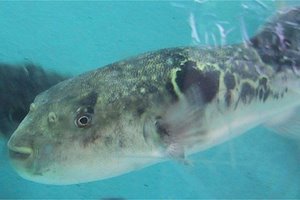Jul. 13, 2007 Research Highlight Biology
Heading in the right direction
Researchers find a gene controlling embryo orientation
 Figure 1: The pufferfish, Takifugu rubripes, has similar genes and compounds to mice controlling the establishment of the A–P axis. © Chris 73
Figure 1: The pufferfish, Takifugu rubripes, has similar genes and compounds to mice controlling the establishment of the A–P axis. © Chris 73
Developmental biologists from RIKEN working with Japanese and Canadian colleagues have located an important gene that regulates the establishment of the head-to-tail or anterior-to-posterior (A–P) axis in mice. The future development of the whole embryo is orientated to this point of reference.
The A–P axis appears before the emergence of the three primary germ layers of body tissue during the process known as gastrulation, when the primitive ball of cells called the blastula folds in on itself to form the more complex, layered structure of the gastrula. Before gastrulation, there are only two types of tissue—epiblast from which the animal proper develops and visceral endoderm (VE) that forms all of the support structures such as blood vessels and nutrient cells.
The establishment of the A–P axis involves interplay between the VE cells and the underlying epiblast. In particular, a group of VE cells furthest from where embryonic structure attaches to the uterus migrates to close to where the head will develop in the epiblast. At the same time VE cells near the posterior end of the axis switch on a gene, Wnt, that produces a compound necessary to initiate gastrulation. In contrast, the VE cells at the head end or anterior visceral endoderm (AVE) produce compounds which block Wnt.
Earlier work has shown that the developmental gene known as Otx2 is critical in the generation and function of the AVE. In mutants lacking Otx2 there is no migration of VE cells to form the AVE and a key antagonist to Wnt is not produced. But the factors that regulated Otx2 were unknown.
In a recent paper in the Proceedings of the National Academy of Sciences1, the researchers from RIKEN’s Center for Developmental Biology in Kobe and their colleagues describe how they used carefully engineered transgenic mice to demonstrate the critical role of the transcription factor Foxa2 in regulating Otx2. In laboratory studies, they also showed that the Foxa2 protein is needed for the production of at least two Wnt antagonists. Through these actions Foxa2 controls the establishment of the A–P axis.
Similar genes and compounds also exist in the pufferfish, fugu (Fig. 1). In fact, the group found, the fugu equivalent of Foxa2 can actually work in mice. According to the researchers, this shows how tightly the whole regulatory system has been conserved in the evolution of higher vertebrates from the bony fishes.
References
- 1. Kimura-Yoshida, C., Tian, E., Nakano, H., Amazaki, S., Shimokawa, K., Rossant, J., Aizawa, S. & Matsuo, I. Crucial roles of Foxa2 in mouse anterior–posterior axis polarization via the regulation of anterior visceral endoderm-specific genes. Proceedings of the National Academy of Sciences USA 104, 5919–5924 (2007). doi: 10.1073/pnas.0607779104
